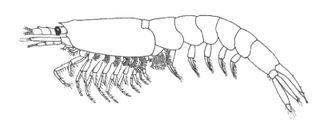
Near-sightedness, also known as myopia and short-sightedness, is an eye disease where light from distant objects focuses in front of, instead of on, the retina. As a result, distant objects appear blurry while close objects appear normal. Other symptoms may include headaches and eye strain. Severe near-sightedness is associated with an increased risk macular degeneration, retinal detachment, cataracts, and glaucoma.

Ponerinae, the ponerine ants, is a subfamily of ants in the Poneromorph subfamilies group, with about 1,600 species in 47 extant genera, including Dinoponera gigantea - one of the world's largest species of ant. Mated workers have replaced the queen as the functional egg-layers in several species of ponerine ants. In such queenless species, the reproductive status of workers can only be determined through ovarian dissections.

Refractive error, also known as refraction error, is a problem with focusing light accurately on the retina due to the shape of the eye and or cornea. The most common types of refractive error are near-sightedness, far-sightedness, astigmatism, and presbyopia. Near-sightedness results in far away objects being blurry, far-sightedness and presbyopia result in close objects being blurry, and astigmatism causes objects to appear stretched out or blurry. Other symptoms may include double vision, headaches, and eye strain.

Bentheuphausia amblyops, the deep sea krill is a species of krill. B. amblyops is the only species within its genus, which in turn is the only genus within the family Bentheuphausiidae. All the 85 other species of krill known are classified in the family Euphausiidae.

Pirenzepine (Gastrozepin), an M1 selective antagonist, is used in the treatment of peptic ulcers, as it reduces gastric acid secretion and reduces muscle spasm. It is in a class of drugs known as muscarinic receptor antagonists; acetylcholine is the neurotransmitter of the parasympathetic nervous system which initiates the rest-and-digest state (as opposed to fight-or-flight), resulting in an increase in gastric motility and digestion; whereas pirenzepine would inhibit these actions and cause decreased gastric motility leading to delayed gastric emptying and constipation. It has no effects on the brain and spinal cord as it cannot diffuse through the blood–brain barrier.

Myopia Hunt Club is a foxhunting and private country club in South Hamilton, Massachusetts, northeast of Boston. In the early years of the U.S. Open, the club hosted it four times: 1898, 1901, 1905, and 1908.
Alcohol myopia is a cognitive-physiological theory on alcohol use disorder in which many of alcohol's social and stress-reducing effects, which may underlie its addictive capacity, are explained as a consequence of alcohol's narrowing of perceptual and cognitive functioning. The alcohol myopia model posits that rather than disinhibit, alcohol produces a myopia effect that causes users to pay more attention to salient environmental cues and less attention to less salient cues. Therefore, alcohol's myopic effects cause intoxicated people to respond almost exclusively to their immediate environment. This "nearsightedness" limits their ability to consider future consequences of their actions as well as regulate their reactive impulses.

The Fuchs spot is a degeneration of the macula in cases of high myopia. It is named after the two persons who first described it: Ernst Fuchs, who described a pigmented lesion in 1901, and Forster, who described subretinal neovascularization in 1862. It occurs due to proliferation of retinal pigment epithelium associated with choroidal hemorrhage. The size of the spots are proportionate to the severity of the pathological myopia.
Cyligramma amblyops is a moth of the family Noctuidae. This species of moth is commonly found in the Gold Coast region of Western Africa, now part of Ghana.

Myopias is a genus of ants in the subfamily Ponerinae. The genus is known from the Oriental, Indo-Australian, and Australasian regions.
The 1908 U.S. Open was the fourteenth U.S. Open, held August 27–29 at Myopia Hunt Club in South Hamilton, Massachusetts, northeast of Boston. Fred McLeod defeated 1899 champion Willie Smith in an 18-hole playoff to win his only major title.
Sustainability marketing myopia is a term used in sustainability marketing referring to a distortion stemming from the overlooking of socio-environmental attributes of a sustainable product or service at the expenses of customer benefits and values. Sustainability marketing is oriented towards the whole community, its social goals and the protection of the environment. The idea of sustainability marketing myopia is rooted into conventional marketing myopia theory, as well as green marketing myopia.

Stigmatomma is a genus of ants in the subfamily Amblyoponinae. The genus has a worldwide distribution, and like most other amblyoponines, Stigmatomma species are specialized predators. First described by Roger (1859), it was for a long time considered to be a synonym of Amblyopone until it was revived as an independent genus by Yoshimura & Fisher (2012) based on worker mandible morphology.

Tranopelta is a Neotropical genus of ants in the subfamily Myrmicinae.

Promyopias is an Afrotropical genus of ant in the subfamily Ponerinae containing the single species Promyopias silvestrii. The rare genus has previously been regarded as a separate genus, as a subgenus and as a provisional synonymy, but was reinstated at genus-rank in 2008.

Buniapone is a monotypic genus of ants in the subfamily Ponerinae. Buniapone amblyops, the single described species, is found in Southern and Southeast Asia.

Ponerini is a tribe of Ponerinae ants with 46 genera and 6 extinct genera.

7-Methylxanthine (7-MX), also known as heteroxanthine, is an active metabolite of caffeine (1,3,7-trimethylxanthine) and theobromine (3,7-dimethylxanthine). It is a non-selective antagonist of the adenosine receptors. The compound may slow the progression of myopia (nearsightedness). It is under investigation for this purpose in children with myopia.













